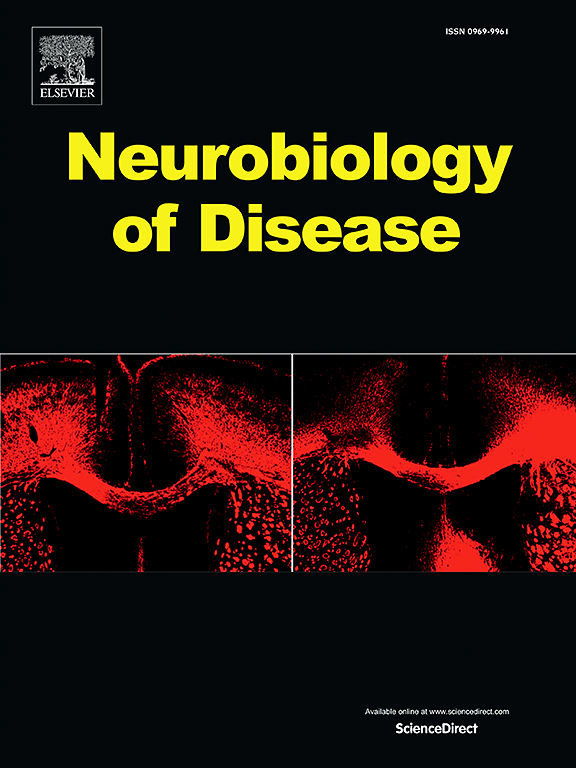Pathological α-synuclein perturbs nuclear integrity
IF 5.6
2区 医学
Q1 NEUROSCIENCES
引用次数: 0
Abstract
Pathological aggregates of α-synuclein are a hallmark of a group of neurodegenerative disorders collectively termed synucleinopathies. The physiological function of α-synuclein, and the detrimental effects of the pathological variants of α-synuclein have been widely debated, but recent evidence has suggested an emerging consensus on a critical role for α-synuclein in regulating synaptic function. However, a controversial role for α-synuclein in nuclear function in both normal and pathogenic states has been proposed, and the degree to which α-synuclein localizes within the nucleus and subsequent impact on the nucleus are poorly understood. To begin to address this controversy, we employed synucleinopathy murine and cell culture models, as well as postmortem human Lewy Body Dementia tissue to elucidate the extent to which pathological α-synuclein localizes within the nuclear compartments, and the downstream consequences of this localization. We observed pathological aggregation of α-synuclein within the nucleus in both murine models and human postmortem Lewy Body Dementia cortex via quantitative super resolution microscopy. In both mouse and human brain tissue the presence of α-synuclein in the nucleus correlated with abnormal morphology of nuclei. This pathological accumulation of α-synuclein in the nucleus was not observed in control mice, human tissue without pathology, or control cells. We subsequently examined the correlated changes in nuclear function with pathological accumulation of α-synuclein in the nucleus. Synucleinopathy models displayed increased levels of the DNA damage marker 53BP1. Furthermore, cells with pathological α-synuclein exhibited elevated markers of nuclear envelope damage and abnormal expression of nuclear envelope repair markers. Our cell culture data also suggests altered RNA localization in response to pathological α-synuclein accumulation within the nucleus. Lastly, we show that nuclear Lewy-like pathology leads to increased sensitivity to nuclear targeted toxins. Taken together, these results rigorously illustrate nuclear localization of pathological α-synuclein with super resolution methodology and provide novel insight into the ensuing impact on nuclear integrity and function.
病理性α-synuclein干扰细胞核完整性。
α-突触核蛋白的病理聚集是一组神经退行性疾病的标志,统称为突触核蛋白病。关于α-synuclein的生理功能,以及α-synuclein病理变异的有害影响一直存在广泛的争论,但最近的证据表明,α-synuclein在调节突触功能中的关键作用正在形成共识。然而,α-synuclein在正常和致病状态下对细胞核功能的作用存在争议,α-synuclein在细胞核内定位的程度及其对细胞核的影响尚不清楚。为了开始解决这一争议,我们采用突触核蛋白病小鼠和细胞培养模型,以及死后人类路易体痴呆组织来阐明病理性α-突触核蛋白在核室内的定位程度,以及这种定位的下游后果。我们在小鼠模型和人死后路易体痴呆皮层中观察到α-突触核蛋白在细胞核内的病理聚集。在小鼠和人脑组织中,α-突触核蛋白的存在与细胞核形态异常有关。α-突触核蛋白在细胞核内的这种病理性积累在对照小鼠、无病理的人组织或对照细胞中均未观察到。我们随后检查了核功能的变化与α-突触核蛋白在细胞核中的病理积累的相关性。突触核蛋白病变模型显示DNA损伤标志物53BP1水平升高。病理性α-synuclein的细胞表现为核膜损伤标志物升高,核膜修复标志物表达异常。我们的细胞培养数据还表明,细胞核内病理α-突触核蛋白积累会改变RNA定位。最后,我们表明核路易样病理导致对核靶向毒素的敏感性增加。综上所述,这些结果用超分辨率方法严格说明了病理性α-突触核蛋白的核定位,并为随后对核完整性和功能的影响提供了新的见解。
本文章由计算机程序翻译,如有差异,请以英文原文为准。
求助全文
约1分钟内获得全文
求助全文
来源期刊

Neurobiology of Disease
医学-神经科学
CiteScore
11.20
自引率
3.30%
发文量
270
审稿时长
76 days
期刊介绍:
Neurobiology of Disease is a major international journal at the interface between basic and clinical neuroscience. The journal provides a forum for the publication of top quality research papers on: molecular and cellular definitions of disease mechanisms, the neural systems and underpinning behavioral disorders, the genetics of inherited neurological and psychiatric diseases, nervous system aging, and findings relevant to the development of new therapies.
 求助内容:
求助内容: 应助结果提醒方式:
应助结果提醒方式:


